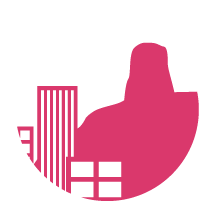The I–Design major is an integrated design program that develops the creative identity through interdisciplinary problem-solving skills, new media and technology, collaboration, and global cultural experience.
The I–Design major provides students with an up-to-date and adaptive design education. As the creative field continues to expand, the program will enable students to become leaders in multiple design-related industries and even their own communities. Employing the Design Thinking methodology, the I–Design major is developed as an integrated design program that is localized for the WSU environment. It develops creative identity through interdisciplinary problem-solving skills, new media and technology, collaboration and global cultural experience.
Building on a foundation that includes studio and digital art, graphic design, interactive technology and design history studies, students will leverage traditional studio skills along with modern tools like professional design software to gain basic creative and design skills. Once formally accepted into the program as sophomores, students are exposed to advanced contemporary design practices. Incorporating knowledge from the cross-disciplinary coursework, students learn to use design thinking to resolve challenges creatively and innovatively. The senior experience includes opportunities to develop campaigns and design productions to promote community projects, participate in a Senior Exhibition, and complete internships with regional businesses.
The Five Objectives of I-Design

Interdisciplinary Creative Studies
Students will be expected to expand the boundary of traditional academic scholarship. They will pursue outside subject areas and incorporate different types of creative problem-solving skills into their design studies.

Integrative Skills
Students learn to collaborate with creative thinkers from other disciplines. It provides students with strategies, skills and concepts to establish and sustain creative thinking and collaboration that results in increased performance and resourcefulness.

Inquiry Learning
The Design Program employs inquiry-based approach to learning to increase intellectual engagement and foster deep understanding through the development of a hands-on, minds-on and ‘research-based disposition’ towards learning. “How to Learn” vs “What to Learn”, Inquiry honors the complex, interconnected nature of knowledge construction, striving to provide opportunities for students to collaboratively build, test and reflect on their learning.

International Exposure
Students in the program must complete a six-credit international exposure that is substantial and directly immerses the student in a different culture. Examples include most study abroad/faculty-led study away programs. This will strengthen student adaptation to the now global design industry. Each international exposure is completed with a group creative exhibition synthesizing the transformative experience. Design Academic Advisor approval is required prior to participating in the cross-culture experience.

Identity Formation
Students develop a strong creative identity through a concentration of cross-disciplinary studies. It allows them to explore and combine their strengths and areas of interests in their design discipline (e.g. engineering, computer science, marketing and writing).
I–Design Concentrations
The I–Design major incorporates a concentration elective (mimicking the area of expertise) that allows students to individualize their program with an area of interest. Student’s work with their Design Academic Advisor to develop a selection of courses that will expand the student’s proficiency in their desired field of design.

Studio Practices
Studio Practices concentration is an opportunity for students who wish to extend their creativity into fine arts. This concentration provides students with the opportunities to develop advanced and creative experimental works. Students may also explore drawing, painting, digital art, photography, installation, sculpture, typography, and video production while discovering their creative identity.
Future careers: Art Director, Industrial Design Contractor, Accessories Design Manager, Packaging Specialist, Partner and Creative Director, 3D Sculptor/Designer and CNC Machinist, Manager of Engineering/Design/Drafting, Owner/Designer, Design Strategist, Curator/Producer, Arts Administrator, Spatial designer, Mural Artist, Gallerist, Art Therapist, Studio Manager, Commissioned Public Artist, and many more.
Student works:

Conceptual Illustration
Conceptual Illustration is an opportunity for students within the I-Design program to transfer ideas into completed professional works of design in a variety of mediums and extend their creativity into industrial-specific studio practices. The execution of ideas is important, but the true spirit of the concentration is the creative process of developing ideas and bringing them to life. The correct combinations of classes can lead students into the following career paths: medical illustration, game conceptual art, graphic art, creative writing, spatial typography, infographics, etc.
Future careers: Multimedia artist & animator, Illustrator, Book / Magazine Designer, Label / Cover Designer: Book, CD, Video, Exhibition / Display Designer, Character Animator, Concept Artist, Comic Book Illustrator, Illustration Historian, Storyboard Artist, Image Curator, Layout Artist, Technical Artist, Texture Artist, 2D Animator, 3D Animator, 3D Character Animator, 3D Modeler, and many more.

Technology & Interactivity
Technology & Interactivity is for students who wish to be on the frontier of design technology and desire to extend their creativity into web technology, programming, UI/UX design, mobile design, mixed reality, game design, interactive installation, data visualization, etc. As technology continues to grow, it offers an abundance of opportunities to develop new visual languages. The Technology & Interactivity concentration allows students to be more appreciative and adaptive to the technology evolution.
Future careers: Interaction Designer, Production Design Manager, User Experience Director, Solutionist, User Interface Visual Designer, Web Consultant, Creative Strategist, Chief Product Officer, Mobile Designer, Flash Animator, Stop-Motion Animator, Character Animator, Website Creative Content Coordinator, Project Coordinator, Creative Strategist, Web Consultant, Design Strategist, Interface Designer, Multimedia Artist & Animator, Designer Coder, UX/UI Designer, and many more.

Business & Marketing
Business & Marketing is an ideal I-Design concentration for students who wish to channel their creativity into a career in business and marketing strategy, entrepreneurship, design manufacturing and production, etc. Study of design and business are intertwined with creativity as a foundation to allow students to thrive in their future career.
Future careers: Communication Design Officer, Principal Designer, Social Media Strategist, Creative Director, Global Head, Employee Communications, Visual Designer, Creative Strategist. Designer Entrepreneur, Business Designer, Advertising & Promotions Manager, Sports Branding Designer, Corporate Branding / Identity / Logo Designer, Chief Visual Officer, Associate Creative Director, Chief Product Officer, Design Strategist and many more.

Sustainable Applications
Sustainable Applications is an opportunity for students within the I-Design program to focus and expand their studies into the sustainable industries and practices. Students have the change to challenge the design industry and better their traditional practices moving toward becoming more environmentally aware. Students are able to utilize the basic skills and techniques of sustainable design and integrate them into their professional work.
Future careers: Landscape Architect, Environmental Design, Solutionist, Project Specialist, Environment Artist, Architect, Integration Artist, Concept Artist, Project Coordinator, Creative Strategist, Visual Designer, Hybrid Design Researcher, Spatial Designer, Sign Designer, Creative Director, and many more.

Community Development
Community development provides students with an opportunity to extend their creativity into social activism, design leadership, and social entrepreneurship. Students develop skills to engage citizens and professionals to build stronger and more resilient communities by providing them with the skills they need to affect change. Designers generate innovative creative solutions to improve non-profits, businesses, and communities.
Future careers: Hybrid Design Researcher, Social Innovator, Art Director,
Communication Design Officer, Creative Strategist, Project
Coordinator, Educator, Design Entrepreneur, Publishing/Layout
Designer, Sign Designer, Exhibition/Display Designer, Social Media Strategist, Solutionist, Community Arts Programmer, and many more.

Integrated Studies
Integrated Studies is a customized and individualized concentration based on special needs and interests. Combination of courses and detailed proposal needs to be approved by the Design Academic Advisor during the sophomore year. Approved course list must be submitted to the Warrior Hub to be added to DARS.
Future careers: Website Creative Content Coordinator, Communication Design Officer, Advertising & promotions manager, Book / Magazine Designer, Associate Creative Director, Art Market Analyst, Visual Designer, Integration Artist, Compositor, Product Image Manager, Image Curator, Photo Editor, Chief Visual Officer, Project Specialist, Solutionist, Principal Designer, and many more.
I–Design (ARTD)
B. A. Major (67 total credits)
The I–Design major provides students with an up-to-date and adaptive design education. Employing the Design Thinking methodology, the I–Design major is developed as an integrated design program that is localized for the Winona State University environment. As the creative field continues to expand, the program will enable students to become leaders in multiple design-related industries and even their communities.
Building on a foundation that includes studio and digital art, basic graphic design theory, and design history studies, students will leverage traditional studio skills along with modern tools, like professional design software, to gain necessary creative and design skills. Once formally accepted into the program as sophomores, students are exposed to advanced contemporary design theory and practices. Design students expand their knowledge and skills and build a professional portfolio through a dynamic and diverse curriculum which includes design history, critical theory, innovative methodology, and engaging practices and techniques. Inquiry, research, collaboration, analysis, and evaluation are core components of the design curriculum as our students become critical and imaginative thinkers responding to contemporary socio-cultural topics through emergent visual communication forms. Incorporating knowledge from the cross-disciplinary coursework, students learn to use design thinking to resolve challenges creatively and innovatively.
The I–Design major incorporates a concentration elective (mimicking the area of expertise) that allows students to individualize their program with an area of interest. Students can choose from Studio Practices, Conceptual Illustration, Technology & Interactivity, Business & Marketing, Sustainable Applications, Community Development, and Integrated Studies.
I–Design program objectives:
- Interdisciplinary Creative Studies: Students will be expected to expand the boundary of traditional academic scholarship. They will pursue outside subject areas and incorporate different types of creative problem-solving skills into their design studies and individual practice.
- Integrative Skills: Students learn to collaborate with creative thinkers from other disciplines. It provides students with strategies, skills, and concepts to establish and sustain creative thinking and collaboration that results in increased performance and resourcefulness.
- Inquiry Learning: The design program employs an inquiry-based approach to teaching and learning to increase intellectual engagement and foster a deeper understanding through the development of a hands-on, minds-on and ‘research-based disposition’ towards teaching and learning. “How to Learn” vs “What to Learn”, Inquiry honors the complex, interconnected nature of knowledge construction, striving to provide opportunities for both instructors and students to collaboratively build, test and reflect on their learning.
- International Exposure: Students in the program must complete a six-credit international exposure that is substantial and directly immerses the student in a different culture. Examples include most study abroad/faculty-led study away programs. This will strengthen student adaptation to the now global design industry. Each international exposure is completed with a group creative exhibition synthesizing the transformative experience. Design Academic Advisor approval is required prior to participating in the cross-culture experience.
- Identity Formation: Students develop a strong creative identity through a concentration of cross-disciplinary studies. It allows them to explore and combine their strengths and areas of interests in their design discipline.
Students are encouraged to declare I–Design as their major upon entering WSU.
Application for formal admission, which takes place in the second semester in the major, requires that students:
- Complete (or be currently enrolled in) ART 150 – Digital Design Fundamentals, ART 243 – Typography and Information Design, and ART 118 – Foundational Drawing.
- Demonstrate software competency. Intermediate level software skills in Photoshop, Illustrator and InDesign are required to take advanced level design courses. Students will be evaluated through their Design Program Application Portfolio. An additional software test is required if a portfolio does not convey the required software skills.
- Submit a portfolio of analog and digital work along with the application form. Because seats are limited, admission to the program is competitive, based on preparation, portfolio, and academic record. Students who are not admitted may reapply.
- ART 118 – Foundational Drawing (3 credits)
- An examination of fundamental concepts in the art of drawing, while students acquire basic studio skills. This course develops visual perception, aesthetic judgment, and sound studio practice. May include work from the nude model. Grade or P/NC. Offered each semester. Recommended to be taken fall semester of your first year in the program.
- ART 150 – Digital Design Fundamentals (3 credits)
- This foundation design course introduces the student to the principles of digital art and design. This is a required course for all design majors. Students will examine a variety of current design tools, which include but are not limited to digital software (Adobe Acrobat, Adobe Photoshop, Adobe Illustrator, and Adobe InDesign), Wacom tablets and touch based devices, as well as explore fundamental elements of design thinking and standard design practices and methodologies. Prerequisite: instructor permission. Grade only. Offered each semester. Recommended to be taken fall semester of your first year in the program. Note: This course has a $100 lab fee.
- ART 219 – Introduction to Contemporary Art (3 credits)
- An introductory course which examines recent and current artistic practices across the world. Focusing on art produced within the last 30 years, Art 219 emphasizes the formal, thematic, and cultural diversity of contemporary art. Grade only. Offered fall semester. Recommended to be taken fall semester of your first year in the program.
- ART 243 – Typography and Information Design (3 credits)
- This class is a fundamental investigation of the expressive principles and potential of typographical form as a critical element intended to convey or evoke a message, statement, idea or emotion through different formats of visual communications and digital media (still and motion). Prerequisite: ART 150 – Digital Design Fundamentals or instructor permission. Grade only. Offered annually (usually spring semester). Recommended to be taken spring semester of your first year in the program. Note: This course has a $100 lab fee.
- CMST 266 – Professional Communication Skills (3 credits)
- Explore and apply theories necessary for appropriate and effective communication in diverse professional and organizational settings. The course emphasizes group collaboration, and oral communication skills, including presentational speaking and the use of presentational technology. The course prepares students to interview for and work in organizational settings, internships, and consulting. Meets GOAL 1. Grade only. Offered annually. Recommended to be taken fall semester of your third year in the program.
- CS 116 – Web Technology (3 credits)
- An introductory, hands-on course on Internet website development. The emphasis is for students to develop competence using web authoring tools and tools for incorporating multimedia into a web page in order to build a complex website focused on some area of academic interest. Students will learn how to plan and publish websites and develop electronic portfolios that are exciting, efficient, accessible, and well-designed. Students will gain insight into the technology behind the World Wide Web by working with CSS (cascading style sheets) and HTML (hypertext) markup language. No prior programming experience is necessary for this course. Grade or P/NC. Recommended to be taken spring semester of your second year in the program.
- ART 277 – Digital Imaging (3 credits)
- This course will explore the technical and conceptual fundamentals of digital imaging with an emphasis on lens-based practices. Students are encouraged to explore the possibilities of the medium, embrace creative risk, and tackle aesthetic concerns as they learn and refine their craft. The course will consist of lectures, demonstrations, studio sessions, class critiques, and explorations of the work of a range of digital and photographic artists. Grade or P/NC. Offered annually. Recommended to be taken fall semester of your second year in the program.
- MCOM 210 – Visual Communication (3 credits)
- Basic visual communication theory as it applies to mass communication with practical, hands-on application. Students explore visual literacy, aesthetics, design principles, creativity, critical evaluation of images in a variety of media, and the ethics of visual communication. Grade only. Recommended to be taken fall semester of your second year in the program.
- ART 260 – Visual and Layout Design (3 credits)
- Students develop a deeper understanding of two-dimensional layout design bridging the gap between traditional print and web design. Using design thinking methodology, students are challenged to develop targeted designs like infographics, data visualizations, small publications, and user interface design. Prerequisites: ART 118 – Foundational Drawing, ART 150 – Digital Design Fundamentals, and ART 243 – Typography and Information Design. Grade only. Offered annually (usually fall semester). Recommended to be taken fall semester of your second year in the program. Note: This course has a $100 lab fee.
- ART 265 – Tactile and Environmental Design (3 credits)
- Students develop a deeper understanding of three-dimensional tactile design that involves material and environmental studies. Through the use of design thinking, students are challenged to develop targeted and innovative products utilizing their skills in packaging, paper engineering, installation, 3D printing, and sustainable design. Students also learn how to document their works by using the product shots. Prerequisites: ART 150 – Digital Design Fundamentals, ART 118 – Foundational Drawing, and ART 243 – Typography and Information Design. Grade only. Offered annually (usually spring semester). Recommended to be taken spring semester of your second year in the program. Note: This course has a $100 lab fee.
- ART 360 – New Media and Technology Design (3 credits)
- Students develop a deeper understanding of time-based and interactive media design. Through the use of design thinking, students are challenged to develop targeted and innovative products using digital tools and programming skills. The course explores coding script, video, human computing interaction, visual coding, virtual reality, augmented reality, digital 3D modeling and the latest technological advancements. Prerequisites: ART 150 – Digital Design Fundamentals, ART 118 – Foundational Drawing, ART 243 – Typography and Information Design, and CS 116 – Web Technology I. Grade only. Offered annually (usually fall semester). Recommended to be taken fall semester of your third year in the program. Note: This course has a $100 lab fee.
- ART 398 – Special Topics in Creative Practices (3 credits)
- This class is an advanced investigation of the expressive principles and potential of contemporary creative practices in the field of studio art and design. Topics vary in response to the changes in the different fields of studio art and design. Students explore creative practices to convey or evoke a message, statement, idea or emotion through different formats or artistic studies, visual communications and media. Prerequisites: ART 118 – Foundational Drawing or ART 150 – Digital Design Fundamentals and instructor permission. Grade only. Offered annually or when demand warrants. Repeatable as topics change. Recommended to be taken spring semester of your third year in the program.
- ART 441 – History of Modern Design (3 credits)
- An in-depth examination of the history and development of modern design, from circa 1800 until the present day. Much attention is paid to the relationship between design innovation and social and technological change. Design objects, tendencies, and movements are analyzed at length. Prerequisite: ART 222 – Survey of Modern Art. Grade only. Offered annually. Recommended to be taken spring semester of your second year in the program.
- ART 350 – Junior Portfolio Review (0 credits)
- A zero-credit course completed by participation in the scheduled portfolio review in either fall or spring of the student’s junior year. Portfolio reviews are scheduled every semester and allow for in-depth conversations between individual students and faculty about the student’s progress, strengths, and creative identity. Students will select 10-12 works for review, hanging them in departmental galleries. P/NC only. Offered each semester. Note: Students fulfill course requirements by participating in portfolio review. Recommended to be taken spring semester of your third year in the program.
- ART 365 – Campaign and Systems Design (3 credits)
- In this course, students utilize creative thinking and profound design skills in both digital and analog formats. Students will complete live projects oriented towards publicity campaign while integrating aspects of 2D, 3D, and new media design practices into visual systems. Prerequisites: ART 260 – Visual and Layout Design, ART 265 – Tactile and Environmental Design, ART 350 – Junior Portfolio Review, and ART 360 – New Media and Technology Design. Grade only. Offered annually (usually fall semester). Recommended to be taken fall semester of your fourth year in the program. Note: This course has a $100 lab fee.
- ART 375 – Advanced Design Project (1-3 credits)
- The course offers students the opportunity to develop in individual and guided environment advanced design projects. In addition to the advancement of current design and problem solving skills, the course focuses on developing creative processes and methodologies as a path to effective design solutions. Prerequisites: ART 260 – Visual and Layout Design or ART 265 – Tactile and Environmental Design or ART 360 – New Media and Technology Design, and instructor permission. Grade only. Offered each semester. Recommended to be taken fall semester of your fourth year in the program.Note: This course has a $100 lab fee. Repeatable up to 4 times.
- ART 460 – Portfolio and Professional Development (3 credits)
- A continued exploration of current professional design practices with primary emphasis on design theories of conceptual visualization for presentation and self-promotion. Through research, discussions, oral presentations, and practical explorations, students will prepare and finalize solutions for individual creative identity and collateral material. Students will also study readings in design criticism and semiotics, including recent or emerging design trends. This is the final step in the Graphic Design/I-Design curriculum whereby students create targeted portfolio pieces for career development. Prerequisite: ART 365 – Campaign and Systems Design or instructor permission. Grade only. Offered annually (usually spring semester). Recommended to be taken spring semester of your fourth year in the program.Note: This course has a $100 lab fee.
- ART 399 – Internship (1-3 credits) (Design Apprenticeship)
- Work-related experience in appropriate settings such as museums, art centers, commercial offices or studios, and public relations offices. Credit hours to be arranged by a faculty member. May be used as a general art elective. Prerequisite: Junior or senior standing. Grade or P/NC. Repeatable up to 9 credits. Recommended to be taken spring semester of your third year in the program.
- ART 433 – Independant Study
- To be arranged with an instructor in studio, art history, or art education. Prerequisites: junior standing and instructor discretion. Instructor and department permission is required. Grade only. Repeatable up to 9 credits.
- Studio Practices
- Conceptual Illustration
- Technology & Interactivity
- Business & Marketing
- Sustainable Applications
- Community Development
- Integrated Studies
CRITICAL ANALYSIS/MATH STATS INTENSIVE COURSE
- ART 360 New Media & Technology Design
ORAL INTENSIVE COURSE
- ART 460 Portfolio & Professional Development
WRITING INTENSIVE COURSES
- ART 365 Campaign & Systems Design
- ART 441 History of Modern Design

